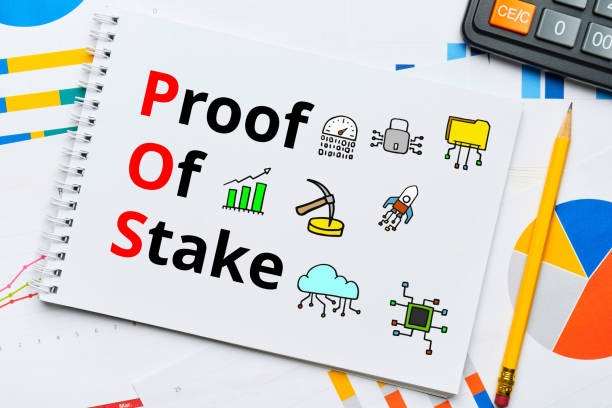Proof of stake (PoS) is a popular mechanism several cryptos use.
Cryptocurrencies require a means to verify transactions because they are decentralized and not controlled by financial institutions.
Proof of stake is a consensus mechanism for cryptocurrencies to validate transactions.
Owners of cryptocurrencies can stake their coins in this system, allowing them to review new transaction blocks and add them to the blockchain.
This approach is an alternative to proof of work, the original cryptocurrency consensus process.
Proof of stake has grown in popularity as the public’s focus has shifted to the environmental impact of cryptocurrency mining.
For those considering investing in Bitcoin, understanding proof of stake is critical.
Definition of Proof of Stake
Proof-of-stake is a consensus mechanism for cryptocurrencies that allows for processing transactions and creating new blocks on a blockchain.
A consensus mechanism is a way of validating entries in a distributed database while also keeping it safe.
In the case of Bitcoin, the database is known as a blockchain, and the consensus mechanism secures the blockchain.
Proof-of-stake minimizes the computing labor required to verify blocks and transactions.
This ensures the blockchain, and therefore a cryptocurrency, remains secure.
Proof-of-stake modifies the way blocks are confirmed using coin owners’ devices.
The owners put their coins up as collateral in exchange for the opportunity to validate blocks.
“Validators” are coin owners who have staked their coins.
Innovative Tech Solutions, Tailored for You
Our leading tech firm crafts custom software, web & mobile apps, designed with your unique needs in mind. Elevate your business with cutting-edge solutions no one else can offer.
Start NowThe block is then “mined,” or validated, by validators who are chosen at random.
Rather than employing a competition-based process like proof-of-work, this system chooses who gets to “mine” randomly.
A coin owner must “stake” a certain coin amount to become a validator.
Before a user can become a validator on Ethereum, for example, they must stake 32 ETH.
Many validators validate blocks, which are finalized and closed when certain validators confirm that the block is correct.
Different proof-of-stake techniques may use different methods for validating blocks.
For example, when Ethereum switches to PoS, it will use shards to submit transactions.
A validator verifies the transactions and adds them to a shard block, which requires the signatures of at least 128 validators.
Read: All You Need To Know About Cryptocurrency

How Does Proof of Stake Work?
Cryptocurrency owners can stake coins and construct their own validator nodes using the proof-of-stake paradigm.
Staking is the act of pledging your coins to be used for transaction verification.
While you stake your coins, they are locked, but you can unstake them if you want to exchange them.
When a block of transactions is ready to be processed, the proof-of-stake protocol for the cryptocurrency selects a validator node to review it.
The validator verifies the accuracy of the block’s transactions.
If this is the case, they upload the block to the blockchain and receive cryptocurrency as a reward for their efforts.
If a validator suggests adding a block with incorrect information, they will be penalized by losing some of their staked holdings.
Let’s look at how Cardano (CRYPTO:ADA), a popular cryptocurrency that uses proof of stake, operates as an example.
Any Cardano owner can stake the coin and create their validator node.
Cardano’s Ouroboros protocol chooses a validator when it needs to validate blocks of transactions.
The validator verifies the block, adds it, and is rewarded with extra Cardano.
Read: Why Are the Gas Fees for TRC-20 Tokens Low?
Mining Power in Proof of Stake
The amount of coins staked by a validator determines mining power in proof of stake.
Participants who stake more coins have a better chance of being chosen to add additional blocks to the game.
Each proof-of-stake mechanism distinctly chooses validators.
Seamless API Connectivity for Next-Level Integration
Unlock limitless possibilities by connecting your systems with a custom API built to perform flawlessly. Stand apart with our solutions that others simply can’t offer.
Get StartedThe selection procedure is normally random and can also be influenced by other criteria, such as how long validators have been staking their coins.
Although everybody staking crypto can be chosen as a validator, the chances are slim if you’re staking a tiny amount.
If your coins account for 0.001% of the total amount staked, your chances of getting picked as a validator are roughly 0.001%.
That is why the majority of players join staking pools.
The owner of the staking pool puts up the validator node, and a group of users pool their funds for a better chance of winning fresh blocks.
The rewards are distributed among the pool’s members.
The pool owner may charge a minor fee.
Read: What is the Difference Between BEP-20 and ERC-20 Tokens?
Goals of Proof-of-Stake
Proof-of-stake is a protocol that aims to address the scalability and environmental sustainability issues that plague the proof-of-work protocol.
Proof-of-work is a competitive approach to transaction verification, which naturally motivates people to hunt for ways to gain an advantage, particularly when money is involved.
By verifying transactions and blocks, Bitcoin miners earn Bitcoin.
However, they pay their operating costs in fiat currency, like power and rent.
Miners are swapping electricity for cryptocurrency, which is what’s going on.
The quantity of energy required to mine a proof-of-work coin significantly impacts pricing and profitability in the market.
PoW mining consumes as much energy as a small country; hence, environmental concerns exist.
The PoS approach addresses these issues by effectively substituting staking for processing power, with the network determining an individual’s mining capabilities.
Because miners can no longer rely on vast farms of single-purpose hardware to gain an edge, energy consumption should drop dramatically.
Read: How to List a Coin or Token on Pancake Swap

Proof-of-Stake Security
The 51% assault, which has long been promoted as a threat to cryptocurrency enthusiasts, is a risk when PoS is used.
But it is extremely unlikely.
People who own 51% of a coin can use that majority to change the blockchain.
A group or individual must own 51% of the staked coin in PoS.
It’s not only prohibitively expensive to own 51% of a staked cryptocurrency—the staked currency serves as security for the right to “mine.”
The miner(s) that undertake a 51% attack to overturn a block will lose all their staked coins.
Transform Business with Custom CRM & ERP Solutions
Elevate your operations with a CRM or ERP tailored for you. Let’s build the perfect solution that others can't replicate—crafted to match your business's needs like no other.
Get StartedThis incentivizes miners to perform ethically in the interest of the cryptocurrency and the network.
Most of PoS’s other security features aren’t highlighted because doing so could open the door to circumventing security safeguards.
Most PoS systems, on the other hand, contain additional security features that supplement the inherent security of blockchains and PoS algorithms.
Read: Blockchain Use Cases: How the Technology is Being Applied in Various Industries
Conclusion
Proof of Stake (PoS) is a vital consensus mechanism that enables cryptocurrencies to validate transactions securely and efficiently.
By allowing coin owners to stake their holdings and become validators, PoS reduces the need for energy-intensive computational work.
This addresses significant environmental concerns associated with traditional Proof of Work (PoW) systems.
With its random selection process, PoS enhances decentralization and security, ensuring the blockchain’s integrity.
Understanding PoS is essential for anyone interested in the evolving landscape of cryptocurrencies.
This is particularly important as more projects adopt this environmentally sustainable and scalable approach to maintain their networks.
Before You Go…
Hey, thank you for reading this blog post to the end. I hope it was helpful. Let me tell you a little bit about Nicholas Idoko Technologies.
We help businesses and companies build an online presence by developing web, mobile, desktop, and blockchain applications.
We also help aspiring software developers and programmers learn the skills they need to have a successful career.
Take your first step to becoming a programming expert by joining our Learn To Code academy today!
Be sure to contact us if you need more information or have any questions! We are readily available.











